Tip Droop Prevention in Rhinoplasty: Dynamic Effect of Strut Graft on Smiling versus Depressor Muscle Release
- PMID: 33868871
- PMCID: PMC8049389
- DOI: 10.1097/GOX.0000000000003462
Tip Droop Prevention in Rhinoplasty: Dynamic Effect of Strut Graft on Smiling versus Depressor Muscle Release
Abstract
Background: Aesthetic rhinoplasty is one of the most challenging procedures performed by aesthetic surgeons. Tip droop, especially on smiling, may not be noted by the surgeon postoperatively but can be concerning to patients. Our aim was to determine if the division of the depressor septi nasi or its combination with a columellar strut graft during rhinoplasty produce a measurable reduction in nasal tip droop on smiling.
Methods: A retrospective casenote and photograph review was conducted on patients who had undergone aesthetic endonasal rhinoplasty, performed by a single surgeon between 2015 and 2019. In total, 29 patients had release of the depressor septi nasi muscle, whilst 11 had release of the muscle along with a strut graft. Lateral smiling photographs were taken postoperatively. Tip droop was measured as a variation of the nasolabial angle from rest to smiling using the Frankfurt line.
Results: Photographs were taken at a mean of 14 months postoperatively. In the group who had muscle release only, a mean increase in nasolabial angle of 3.66 degrees was seen when smiling when compared with rest. In the group who had muscle release combined with strut graft, a mean increase of 2.27 degrees was seen. When using a columellar strut along with muscle release, tip droop on smiling was reduced.
Conclusions: This study demonstrates that columellar strut grafting in combination with muscle release can alleviate drooping of the tip better than muscle division alone after rhinoplasty. The columellar strut graft provides tip stability and can therefore be used to enhance dynamic outcomes after rhinoplasty.
Copyright © 2021 The Authors. Published by Wolters Kluwer Health, Inc. on behalf of The American Society of Plastic Surgeons.
Conflict of interest statement
Disclosure: The authors have no financial interest to declare in relation to the content of this manuscript.
Figures
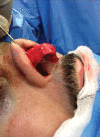

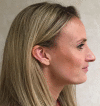

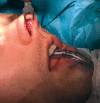


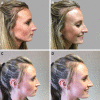
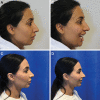

Similar articles
-
Treatment of hyperdynamic nasal tip ptosis in open rhinoplasty: using the anatomic relationship between the depressor septi nasi muscle and the dermocartilaginous ligament.Aesthetic Plast Surg. 2012 Aug;36(4):819-26. doi: 10.1007/s00266-012-9893-2. Epub 2012 Apr 13. Aesthetic Plast Surg. 2012. PMID: 22527586
-
Open rhinoplasty using a columellar strut: effects of the graft on nasal tip projection and rotation.Eur Arch Otorhinolaryngol. 2020 May;277(5):1371-1377. doi: 10.1007/s00405-020-05836-9. Epub 2020 Feb 15. Eur Arch Otorhinolaryngol. 2020. PMID: 32062744
-
Smile analysis in rhinoplasty: a randomized study for comparing resection and transposition of the depressor septi nasi muscle.Plast Reconstr Surg. 2014 Feb;133(2):261-268. doi: 10.1097/01.prs.0000436850.86785.24. Plast Reconstr Surg. 2014. PMID: 24469161 Clinical Trial.
-
Depressor septi nasi modifications in rhinoplasty: a review of anatomy and surgical techniques.Facial Plast Surg. 2014 Aug;30(4):471-6. doi: 10.1055/s-0034-1383550. Epub 2014 Jul 30. Facial Plast Surg. 2014. PMID: 25076456 Review.
-
Multifactorial approaches for correction of the drooping tip of a long nose in East asians.Arch Plast Surg. 2014 Nov;41(6):630-7. doi: 10.5999/aps.2014.41.6.630. Epub 2014 Nov 3. Arch Plast Surg. 2014. PMID: 25396173 Free PMC article. Review.
Cited by
-
A cross-sectional study to correlate nasal profile and chin position with cephalometric lip profile.J Orthod Sci. 2024 Nov 25;13:39. doi: 10.4103/jos.jos_28_24. eCollection 2024. J Orthod Sci. 2024. PMID: 39758102 Free PMC article.
-
Nasal Tip Depressor Manipulation through Upper Buccal Sulcus Approach in Selected Open Primary Rhinoplasties.Plast Reconstr Surg Glob Open. 2022 Aug 19;10(8):e4481. doi: 10.1097/GOX.0000000000004481. eCollection 2022 Aug. Plast Reconstr Surg Glob Open. 2022. PMID: 35999881 Free PMC article.
-
Effect of Depressor Septi Transposition on Preventing Tip Droop During Smiling in Tongue-in-Groove Tip Plasty: A Randomized Controlled Trial.Aesthetic Plast Surg. 2025 May 28. doi: 10.1007/s00266-025-04966-x. Online ahead of print. Aesthetic Plast Surg. 2025. PMID: 40437118
References
-
- Rohrich RJ, Ahmad J. A practical approach to rhinoplasty. Plast Reconstr Surg. 2016; 137:725e–746e - PubMed
-
- Herruer J, Prins J, van Heerbeek V, et al. . Does self-consciousness of appearance influence ostoperative satisfaction in rhinoplasty? J Plast Reconstr Aesthet Surg. 2018; 71:79–84 - PubMed
-
- Sinno S, Chang JB, Saadeh PB, et al. . Anatomy and surgical treatment of the depressor septi nasi muscle: A systematic review. Plast Reconstr Surg. 2015; 135:838e–848e - PubMed
-
- Kosins AM, Lambros V, Daniel RK. The plunging tip: Illusion and reality. Aesthet Surg J. 2014; 34:45–55 - PubMed
LinkOut - more resources
Full Text Sources
Other Literature Sources
